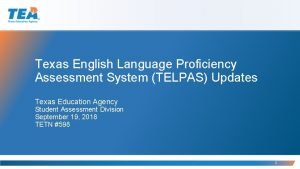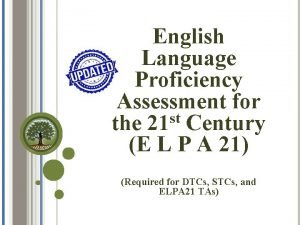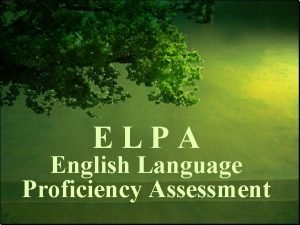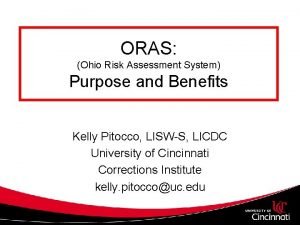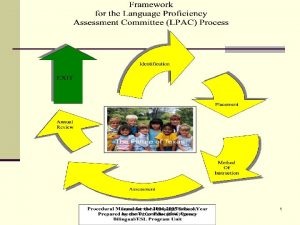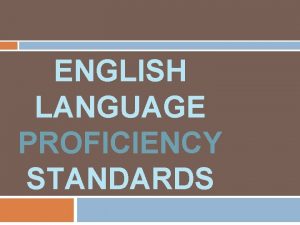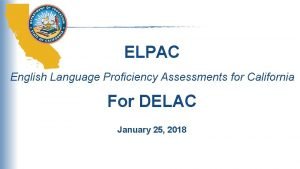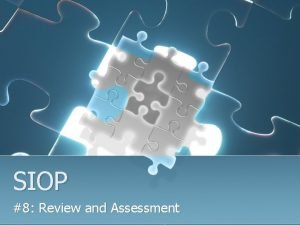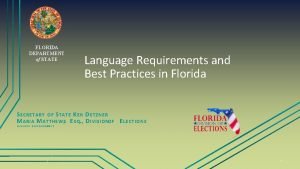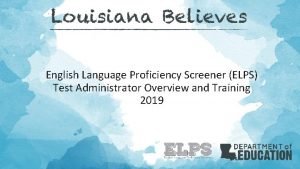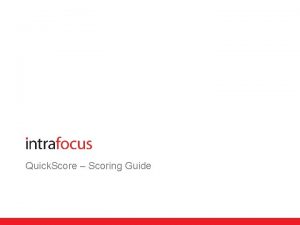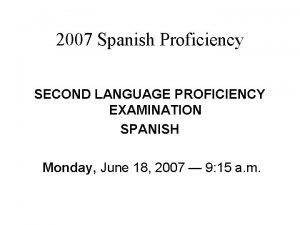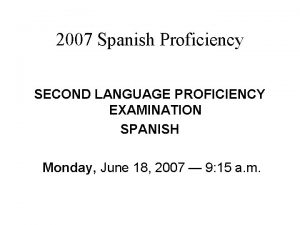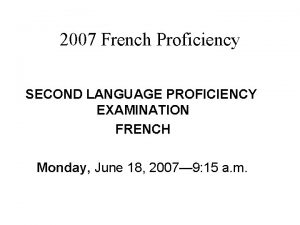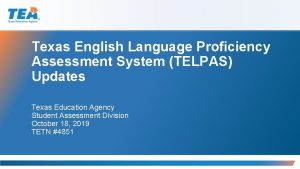Ohio English Language Proficiency Assessment OELPA Local Scoring













- Slides: 13

Ohio English Language Proficiency Assessment (OELPA) Local Scoring for Speaking Test

Tutorial Objectives After viewing this tutorial, test administrator* (TA) should be able to: • Conduct the scoring procedure • Use rubrics to consistently assign score points • Employ holistic scoring to make appropriate scoring decisions *TA must meet criteria – must be employee of district and hold a current license, certificate or permit issued by the Ohio Department of Education. 2

Local Scoring Overview Instructions for TA: • Speaking test scored “live” with one student and one TA in a room with no other students in the room no matter how large the room, i. e. gym • TA assigns scores and records scores in the Data Entry Interface (DEI) • Scores may be entered in the DEI at the time of testing, or after all student testing is completed but before the test window closes on March 30 th • The DEI User Guide and a DEI Tutorial have been posted on the portal • One student with one TA in one room – failure to follow oneto-one rule results in test being invalidated; also a security violation

Required Materials TA will need for the speaking test: • Directions for Administration Paper-Pencil Manual which includes: • Script to be read aloud to the student; • Introductions to each audio track on the CD; and • CD containing audio stimuli; and • Test booklet for the student. • Speaking Local Scoring Document (includes the rubric used to score the student response, and specific instructions for the DEI. ) Please note the student may listen to the CD track as often as needed and may respond as often as needed.

Student’s Response Instructions during test: • Student listens to the question/task; • Student gives oral response; • TA writes student response in the test booklet; • TA reviews student response and scores; • TA enters score into DEI (when scores are entered into DEI is determined by the TA as long as it is completed before the test window closes on March 30 th).

Scoring Decisions Responses are scored holistically: • Gives student a single, overall score for the response as a whole; • Balances strengths and weaknesses among the various criteria described in the rubric; and • Does not depend on the exact number of errors or assign a score for each detail.

Scoring Decisions Holistic Scoring of Clustered Questions/Tasks: • Responses should be scored holistically across all parts • Significant grammatical errors in some responses in the set could reduce the overall score based on the degree to which it interferes with scorer understanding

Scoring Decisions Rubrics • A 5 point rubric: • 5 point – student response clearly and completely answers the question • 4 point – student response addresses the question but leaves out minor detail or description or has minor error • 3 point – student response addresses the question/task but not fully developed • 2 point – student response addresses the question/task but errors/lapses obscure meaning • 1 point – student responds with a word or phrase that can be tied to the question/stimulus or response barely answers the question • 0 point – student response does not address communicative demands of task/question

Scoring Decisions Rubrics • A 4 point rubric: • 4 point – student response clearly and completely answers the question/task • 3 point – student response addresses the question/task but leaves out some detail or description • 2 point – student response addresses the question/task but errors/lapses obscure meaning • 1 point – student responds with a word or phrase that can be tied to the question/stimulus or response barely answers the question • 0 point – student response does not address communicative demands of task/question

Scoring Decisions Rubrics • A 3 point rubric: • 3 point – student response clearly and completely answers the question • 2 point – student response addresses the question but leaves out some detail or description • 1 point – student responds with a word or phrase that can be tied to the question/stimulus or response barely answers the question • 0 point – student response does not address communicative demands of task/question

Rubrics Scoring Decisions A 2 point rubric: • 2 point – student response clearly and completely answers the question • 1 point – student responds with a word or phrase that can be tied to the question/stimulus or response barely answers the question • 0 point – student response does not address communicative demands of task/question

Scoring Decisions Rubric – applies to all grade bands Specific Student responses that would result in a score point of 0: • Does not address demand of task; • Student response is only in a language other than English; • Refusal/Blank – student does not give a response or student response of, “Yes, No, I don’t know” • Off Task/Topic – student response is not related to question/stimulus • Unintelligible – student response does not make sense No score given - Technological Issue – student cannot respond as the CD or CD player does not work and question/task needs to be readministered when replacement CD obtained

Questions Ohio Help Desk American Institutes for Research • Tel: 1 -877 -231 -7809 • Email: OHHelpdesk@air. org
 Oelpa test
Oelpa test Telpas rubric
Telpas rubric English language proficiency assessment (elpa)
English language proficiency assessment (elpa) Elpa test
Elpa test Oras-cst scoring guide
Oras-cst scoring guide What does lpac stand for
What does lpac stand for English language proficiency (elp) standards scavenger hunt
English language proficiency (elp) standards scavenger hunt Elpe tamu
Elpe tamu Elpac descriptors
Elpac descriptors Review and assessment siop
Review and assessment siop Language english proficiency
Language english proficiency Elps texas standards
Elps texas standards Tide elpt
Tide elpt Scoring a script examples
Scoring a script examples

